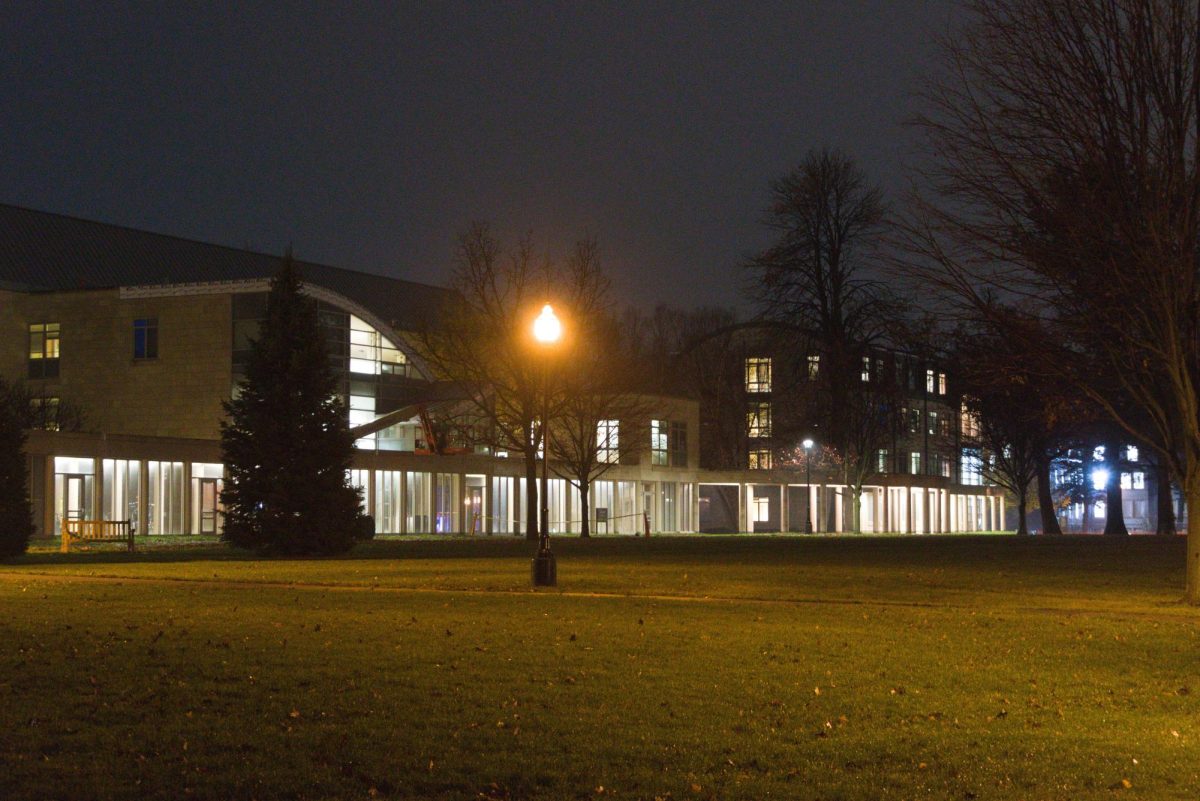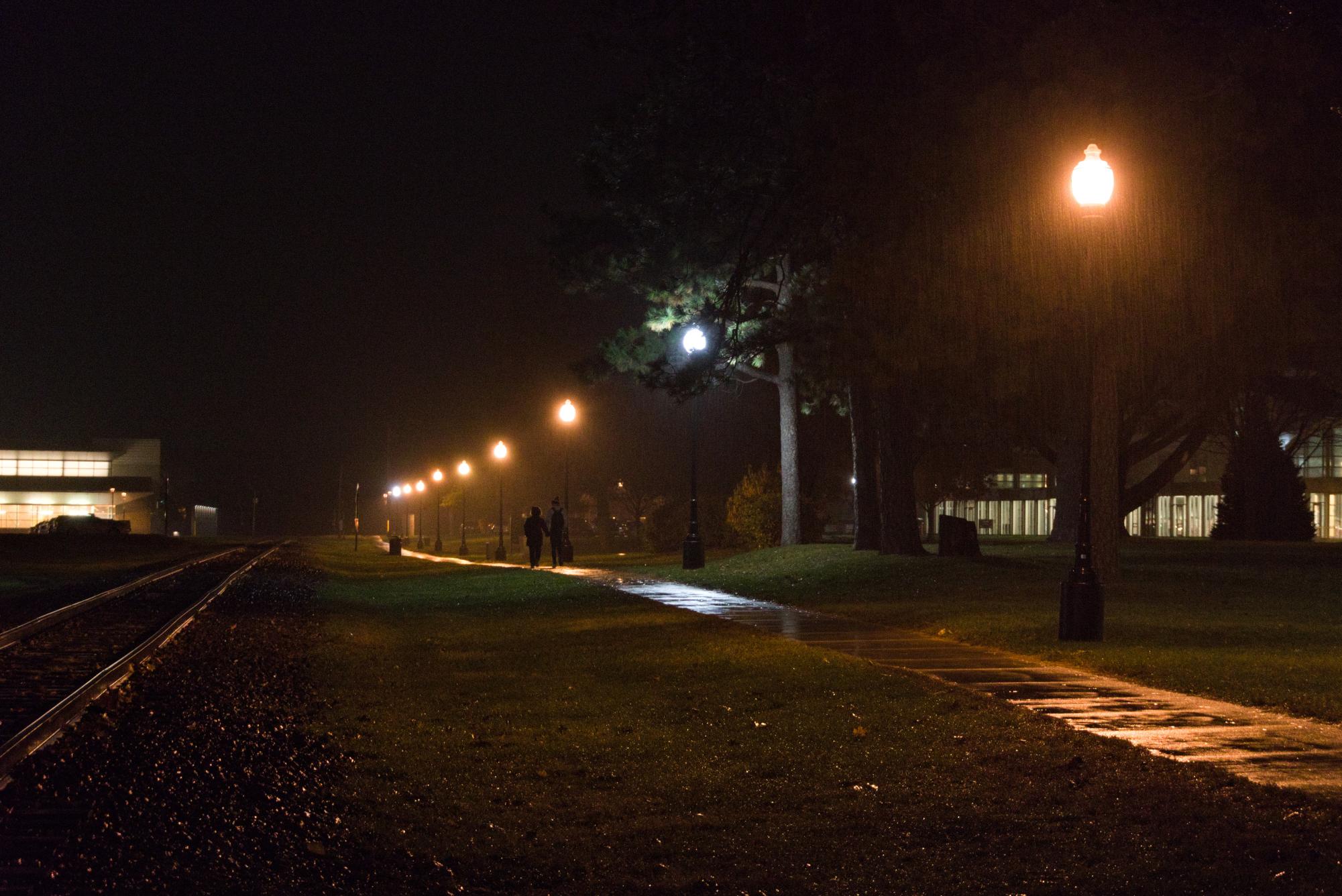Some students at Grinnell College have said they feel unsafe walking around campus at night due to a lack of quality lighting. The Outdoor Safety and Lighting Committee has been evaluating and updating lighting on campus continuously since it first met in 2019, according to Rick Whitney, assistant vice president for Facilities Management. However, some students say these efforts have fallen short, particularly in South Campus.
“I live in South Campus, so I may be biased, but I do think South [Campus] has pretty bad lighting,” Paige Sargent `27 said. “Especially because the lights are always flickering.”
Clara Bode `26, who lives in East Campus, also said South Campus feels particularly unsafe. “The lack of lighting has been driving me insane, especially coming from South [Campus], with the construction,” she said, referring to the construction on Loose Hall.
“Although there may be areas of campus that are not as well-lit, we would not characterize the campus lighting as ‘bad,’” Whitney wrote, adding that the committee and the College balance a multitude of factors, including safety, energy consumption and light pollution around the observatory.
Bode, who often walks through South Campus after Contra and Swing practices, struggles with depth perception. “I can’t see where the sidewalk is messed up in the dark,” said Bode. “It’s a tripping hazard. I have to pay more attention than usual.”
Olivia Brown `28 said that parts of North Campus also feel unsafe. “By Younker is pretty well lit, but Mac Field is total darkness,” she said.

“I know of a couple lamp posts around Grinnell that flicker out when you walk towards them,” Erich Raumann `27. “They’re like reverse motion activated.”
The discrepancy in lighting around the College may be partially due to the age of the lighting. Whitney said that the pole lighting in East Campus is more recent, from around the year 2000. North Campus and South Campus were built in the early 1900s, with the existing pole lighting being installed in the 1980s. “Several pole light fixtures have been added since then to provide consistent spacing and light coverage along the sidewalks,” said Whitney.
The conversation surrounding the lighting situation is ongoing. The Outdoor Safety and Lighting Committee discussed its new focus of improving the current lighting to be brighter and more effective at their semi-annual meeting on Nov. 19. The committee had previously been focused on identifying areas on campus with unsatisfactory lighting.
“Right now, we are in the midst of a project to change out the pole light fixtures to modern full-cutoff LED fixtures,” said Whitney. The project has been going since 2018, with plans for the new lighting to be completely installed by 2026. “A total of 171 pole lights fixtures will be replaced, with about half of the project currently completed,” said Whitney.
Each light fixture costs between $5,000 to $8,000 each, including the pole base, pole, LED and wiring. Their current plan of changing the LED alone costs about $2,500 each.
With winter coming, and snow becoming more prevalent, students may worry about safety more. “I’ve dealt with ice in poor lighting,” Raumann said, who is from Chicago, “but other people that don’t have that experience might have some risks, and the administration should be more careful about maintaining the sidewalks.” Bode also worries about the upcoming weather. “It [the lighting] makes me worried about when it gets icy, what’s it going to be like?”
When walking back from off-campus parties, students feel relatively safe. Sargent, who lives closer to off-campus parties, said that she “usually feel[s] safe unless it’s really late and there’s no one else around. The lighting isn’t great by High Street.” Brown, who lives in North Campus, usually walks with other people. “I’m usually with someone, but if I had to walk from High Street to North [Campus] by myself, I’d be scared.”
Campus Safety is working to help students be and feel safer at night. In an email to The S&B, James Shropshire, director of Campus Safety, said that Campus Safety works 24/7 to support the community. “One of the ways we prioritize safety is through our escort service,” said Shropshire, “which ensures anyone in the campus community can receive a safe ride when needed.” Shropshire said that anyone worried about walking in the dark should share their plans with a trusted friend, roommate, or family member.
Students said they use a variety of methods to keep themselves safe on campus. Brown sometimes carries a taser to protect herself. “I usually keep it in my room, but sometimes I take it out,” said Brown. Bode will often use her phone flashlight to light the path, but she also will call someone on speaker at night. “Normally I wouldn’t do that, but I’m alone at night. You aren’t going to do anything to me when I’m on speaker,” Bode said.







